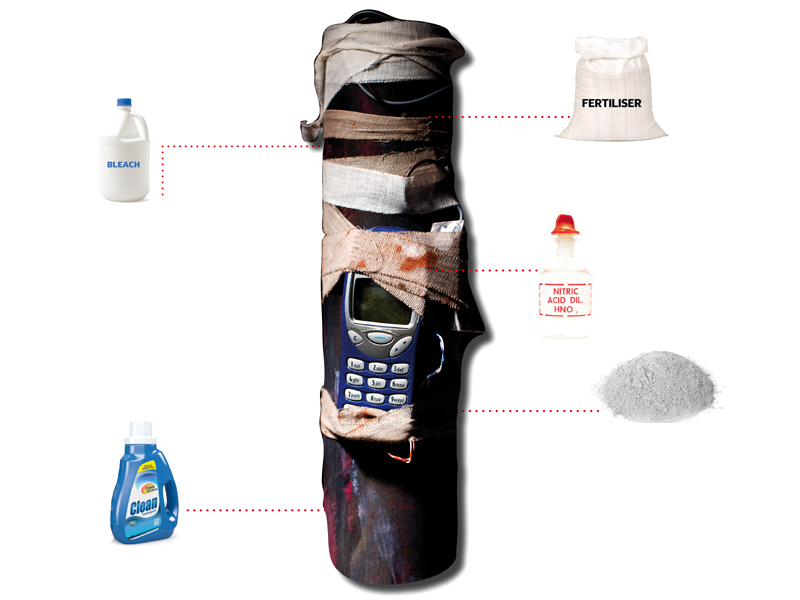
It is the perfect weapon for asymmetric warfare and urban militant groups. The Improvised Explosive Device (IED), or crudely homemade bomb, has increasingly been used by insurgents on both sides of the Durand Line. Reason: It’s cheap and easy to make.
More than 51,000 people have lost their lives as a result of IED blasts since the war against terrorism began, said Director-General Military Operations Major General Ishfaq Nadeem Ahmad at the C-IED symposium in Rawalpindi on May 20.

At the same symposium, army chief Ashfaq Parvez Kayani said, “The threat and impact of these weapons is not [just] Pakistan-specific. These have been used with unfortunate consistency in Iraq and Afghanistan. The recent Boston bombings involving the use of an IED manifest the international dimension of this threat and serves as a stark reminder that even the most developed nations of the world remain vulnerable to this threat.”
Unfortunately, this cardinal security peril does not seem to be a priority for the government and LEAs.

Moreover, The Express Tribune has learnt that provincial governments have failed to take charge of the explosives department from the Centre even after the 18th constitutional amendment, which devolved some ministries and federal government bodies to the provinces. The explosives department is meant to check the sale and purchase of explosives as well as to ensure the implementation of regulations.
A highly-classified report prepared by an intelligence agency, forwarded to the police and other law-enforcement agencies (LEAs), pointed out several flaws and grey areas, regarding the sale and purchase as well as the poor monitoring of explosive material, particularly IED components.

The report states that the general public and the LEAs are neither fully aware of the use of the homemade bombs nor do they know how to tackle the menace. The security system and apparatus is quite vulnerable because the rules and laws are not implemented and there is a dearth of community participation, the report concluded.
Our LEAs are not properly trained vis-a-vis IEDs and even the bomb disposal squads lack the requisite training and proper equipment.
Terrorists exploit these liabilities, as is exemplified by the increasing number of IED attacks.

It is imperative to note that SOPs in this regard either do not exist or have not been implemented.
Deadly weapon
IEDs are in demand purely because of efficiency – minimal cost, high yields. High casualties, rather.
With abundant knowledge, easy availability of IED precursors, increasing lethality, effortless concealment, accurate targeting along with an exceptionally low cost, the IEDs are the ‘perfect’ weapon of choice for terrorists.
The unmonitored sale of IED precursors in the industry and local markets, alongside the vendor industry of electronics, pose a serious threat to Pakistan regarding the manufacture and profuse supply of IEDs.

Chemical precursors are available in various forms and have a wide variety of use. Due to their dual usage, these chemicals are legal to purchase, store and transport. These can be easily converted to homemade bombs and form the charge (explosive) of the IED.
Most common chemical precursors include ammonium nitrate, urea, nitric acid, aluminium powder, potassium chlorate, peroxides etc.
Similarly, electronic precursors – used to detonate the main charge – are also readily available in local markets of Pakistan. Remote-control devices such as garage openers and car security alarms are purchased and used by terrorists to make the initiator (fuse) for IEDs.
Counter-IED measures
Due to the difficulty in checking the open market of IED components, a mechanism needs to be in place to thwart the prevalent use of the improvised bomb.
According to the rules of the Pakistan Telecommunication Authority (PTA), permissible range of the remote control device to be sold in the country is 10 metres.
Provinces should take charge of the explosive department and foolproof SOPs ought to be implemented to monitor the flow of commercial explosives.
Nevertheless, some measures have been taken. The country has taken steps to prevent locally made fertiliser for agriculture from being used as explosives in roadside bombs that target American troops in Afghanistan.
Many of the IEDs used in Afghanistan contain materials derived from calcium ammonium nitrate fertiliser produced in Pakistan at two factories.
However, even if the supply or availability of calcium ammonium nitrate is curbed, there is a chance that terrorists may switch to another precursor.
LEAs could be especially trained on IED recognition and bomb scene management, the report concluded.
Meanwhile, LEAs need to undergo proper training as some of them cannot even recognise an IED. Specialists of such roadside and homemade bombs are very well aware of this vulnerability, according to the highly-classified report.
LEAs could be especially trained on IED recognition and bomb scene management, the report concluded.
What is an IED?
An IED is a homemade bomb constructed and deployed in ways other than conventional military action. It is built on the same grounds as a conventional explosive. It has five components: a switch (activator), an initiator (fuse), container (body), charge (explosives), and a power source (battery). An IED is specifically designed for use against armoured targets such as personnel carriers or tanks.
Potassium chlorate can be made from common household bleach and a salt substitute. It is also present in fertilisers, safety matches and fireworks.
A new invention? Not quite
The term IED comes from the British army in the 1970s, after the Provisional Irish Republican Army (PIRA) used bombs made from agricultural fertiliser and Semtex smuggled from Libya to make booby-trap devices or remote-controlled bombs. IEDs were also extensively used by the Liberation Tigers of Tamil Eelam against Sri Lankan military targets.
Peroxides due to their bleaching effect are used in detergents and hair dyes. Variations of the compound are also used in dental products.
Ammonium Nitrate and Urea is a common component of most agricultural fertiliser and can be found in instant cold packs. It is also a major compound in most explosives and can be used to alter rate of explosions.
Nitric Acid is a highly corrosive acid used in the manufacture of fertilisers and explosives. It is also used in a range of industrial metallurgical processes.
Aluminum powder is used to enhance the effect of the blast. It is commonly found as a component of flash powders.
Published in The Express Tribune, October 20th, 2013.
COMMENTS (7)
Comments are moderated and generally will be posted if they are on-topic and not abusive.
For more information, please see our Comments FAQ





1725254039-0/Untitled-design-(24)1725254039-0-270x192.webp)
1732189200-0/Express-Tribune-(13)1732189200-0-270x192.webp)



1732186994-0/Untitled-design-(10)1732186994-0-270x192.webp)






@unbelievable: Dear unbelievable, Any first year student with a computer knows what the basics of IED's are. When I was a kid on bonfire night we would fill a bin with fire crackers, put on the lid and the resulting explosion was quite spectacular. Things have moved on since then, but what we really have to worry about is the idiocy of leaders who encourage terrorism by attacking countries for the profit motive, whilst pretending they are doing it for peoples well being. The old days when the West could attack illiterate brown skinned people with impunity are gone forever. You should really look at the big picture for a change.
Go ahead and upload IED making vedeo instructions too so when casualities increases we have the public proof of the mastermind behind it. This is in sane and depressing reporting!
@Bilal and unbelievable: Not that simple.
The report states that the general public and the LEAs are neither fully aware of the use of the homemade bombs nor do they know how to tackle the menace... it is our agencies who have trained them...
No wonder we are our own victims.
Whats wrong with you guys. You have a hidden agenda for describing these lethal substances in detail. Go on, also publish some circuit diagrams for the convenience of terrorists. This is hight of irresponsible journalism.
What kind of journalism is this?You people have described all the ingredients and procedure for making bombs.Wonder who will take advantage of this article